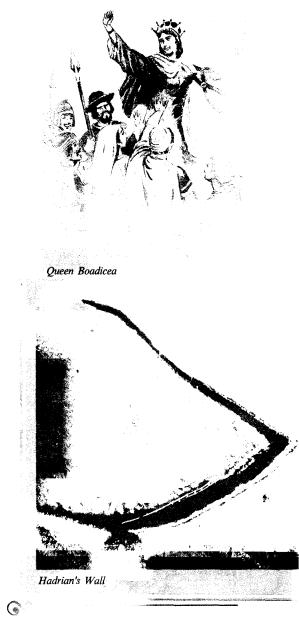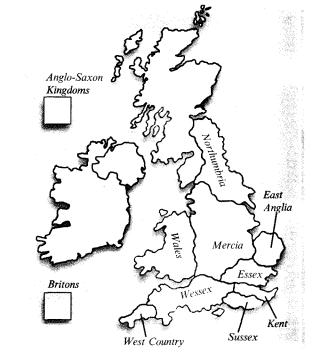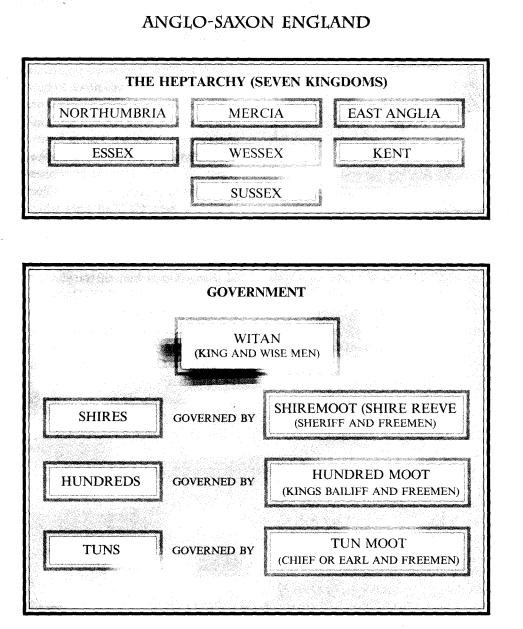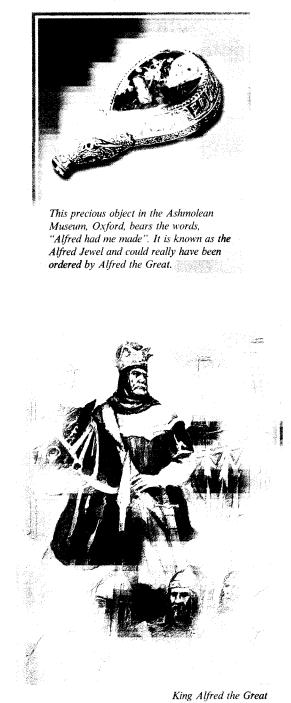
- •CONTENTS
- •BRITAIN IN MIDDLE AGES 13
- •ANCIENT BRITAIN
- •Had Harold waited and given his army a rest, the outcome of the battle might have been different.
- •BRITAIN IN MIDDLE AGES
- •early middle ages
- •later middle ages
- •Key words, terms and concepts
- •Anglo-Norman Britan
- •Later Middle Ages
- •Britain in Late Middle Ages
- •THE STUARTS AND THE STUGGLE OF THE PARLIAMENT AGAINST THE CROWN
- •THE 18тн CENTURY–OF WEALTH, TECHNOLOGICAL REVOLUTION AND POWER
- •Содержание
ANCIENT BRITAIN
INVASION, RESISTANCE, SETTLEMENT and CONQUEST
PRE CELTIC AND CELTIC PEOPLE. ANGLO-SAXON BRITAIN. INVASIONS OF THE VIKINGS. THE ENGLAND OF ALFRED THE GREAT. EDWARD THE CONFESSOR. THE BATTLE OF HASTINGS.
Key words, terms and concepts:
1.Stonehenge
2."Beaker" people
3.Celts, Druids, Celtic curves
4.Celtic languages – Gaelic and Brythonic
5.Roman Britain
6.Hadrian's Wall
7.Scots and Picts
8.Queen Boadicea– (Boudicca)
9.Villas
10.Roman roads – straight as a die
11.Pax Romana, Roman Peace
12.Saxons: Saxon kings and Saxon kingdoms:
Northumbria, Mercia, East Anglia, Sussex, Wessex, Essex, Kent
13.Vikings
14.Venerable Bede (731)
15.Alfred the Great (849-899)
16.The Danelaw
17.Edward the Confessor (1042-1066)
5

The very first stages of the existence of people on the British Isles are frequenly described as prehistoric and referred to as unwritten history of Britain.
The geographical position of the land was both a blessing and a problem: on the one hand the insular position protected the country from invasions; and on the other – the lowland facing the continent always invited invasions.
The greatest material monument of the ancient population of the British Isles is Stonehenge on the Salisbury plain,– a monumental stone circle and a memorial of the Stone Age culture.
The first ever inhabitants are believed to be hunters of the Old Stone Age who came from the Continent, to be followed by new waves of imigrants.
By the end of the Stone Age the Beaker people who were called so after the clay mugs or "beakers" they could make,– were farmers and metal was already being used.
The beginning of the Stone Age coincided with the arrival of new invaders, mainly from France. They were the Celts. Reputed to be tall, fair and well built, they had artistic skills and were good craftsmen. Their dialects were imposed on the native population: the Gaelic form was spread in Ireland and Scotland, and the Brythonic in England and Wales. It was the Brythonic tribe of the Celts that gave its name to the whole country.
The culture of Celts in the Iron Age was not altogether barbaric. Their Priests, the Druids, were skillful in teaching and administration.
But the Romans came with a heavy hand, And bridged and roaded and ruled the land,...
wrote R. Kipling
6

The Roman Emperor Julius Caesar carried out two expeditions in 55 and 54 ВС, neither of which led to immediate Roman settlement in Britain. Caesar's summer expeditions were a failure. Almost a century later in 43 AD Emperor Claudius sent his legions over the seas to occupy Britain. The occupation was to last more than three centuries and the Romans saw their mission of civilizing the country. The British were not conquered easily. There was a resistance in Wales and the Romans destroyed the Druids, a class of Celtic priests (or witchdoctors) as their rutuals alledgedly involved human sacrifice.
There was a revolt in East Anglia, where Queen Boadicea (Boudicca) and her daughters in their chariots were fighting against Roman soldiers and were defeated. The Roman occupation was spread mainly over England, while Wales, Scotland and Ireland remained unconquered areas of the Celtic fringe – preserving Celtic culture and traditions.
The Romans were in Great Britain for over 350 years, they were both an occupying army and the rulers. They imposed Pax Romana,– Roman peace – which stopped tribal wars, and protected Britain from the attacks of outsiders – Picts in the North, Saxons from overseas.
7

London is a Celtic name, but many towns that Romans built along their roads – Lancaster, Winchester, Chichester, etc. have the Latin component "castra"– a camp, a fortified town.
London was the centre of Roman Rule in Britain, it was walled, the Thames was bridged; and straight paved roads (Roman Roads,– that are as straight as a die) connected London with garrison towns.
Under the Emperor Hadrian in 120 AD a great wall was built across Britain between the Tyne and the Solway to protect the Romans against the attacks of Scots and Picts.
Hadrian's wall was a vast engineering project and is a material monument of the Roman times alongside with roads, frescoes and mosaics on the villas and baths (in the city of Bath).
The Romans also brought Christianity to Britain and the British Church became a strong institution. The native language absorbed many Latin words at that time.
By the fifth century the Roman Empire was beginning to disintegrate and the Roman legions in Britain had to return back to Rome to defend it from the attacks of the new waves of barbaric invaders. Britain was left to defend and rule itself.
Acceding to the writing of Venerable Bede, an English monk, barbaric teutonic tribes of Angles, Saxons and Jutes were making raids against the British throughout the fifth and sixth centuries. The British Celts tried to check the Germanic tribes, and that was the period of the half-legendary King Arthur and his knights of the Round Table who defended Christianity against the heathen Anglo-Saxons.
The Germanic invaders first arrived in small groups throughout the fifth century but managed to settle and oust the British population to the mountainous parts of the Isle of Great Britain.
The Anglo-Saxons controlled the central part of Britain which was described as England while the romanized
8

Celts fled West taking with them their culture, language and Christianity. The Anglo-Saxon England was a network of small kingdoms.
The seventh century saw the establishment of seven kingdoms: Essex (East Saxons), Sussex (South Saxons), Wessex (West Saxons), East Anglia (East Angles), Kent, Mersia and Northumbria, and the largest three of them – Northumbria, Mercia and Wessex – dominated the country at different times.
The Anglo-Saxon kings were elected by the members of the Council of Chieftains (the Witan) (see Chart I, p. 9) and they ruled with the advice of the councilors, the great men of the kingdom. In time it became the custom to elect a member of the royal family, and the power of the king grew parallel to the size and the strength of his kingdom. In return for the support of his subjects,– who gave him free labour and military service, paid taxes and duties – the King gave them his protection and granted lands.
By the end of the eighth century the British Isles were subjected to one more invasion by nonChristian people from Scandinavia.
...But the Romans left And the Danes blew in...
That's where your history book begins...
R. Kipling
9

10

Note how Anglo-Saxon England was divided into Seven Kingdoms, known as the Heptarchy. The chart shows how each Kingdom was split up, and how each part had its own moot, or council, to look after its affairs. The Witan was the council for the country.
Chart I
11

They were called Norsemen or Danes, or the Vikings. The Vikings were brilliant sailors, they had the fastest boats in Europe, that were moving powered by sail. They crossed the Atlantic, and founded a colony in North America 500 years before Columbus. They had repeatedly raided the Eastern Coast of England, and by the middle of the ninth century almost all English Kingdoms were defeated by the Danes. In 870 only Wessex was left to resist the barbaric Danes. At that time the West Saxons got a new young King, his name was Alfred, later he was called Alfred the Great. And no other king has earned this title. Alfred forced the Danes to come to terms – to accept Christianity and live within the frontiers of the Danelaw – a large part of Eastern England, while he was master of the South and West of England.
King Alfred was quick to learn from his enemies: he created an efficient army and built a fleet of warships on a Danish pattern, which were known to have defeated Viking invaders at sea more than once. They were forced to go South and settle in Northern France, where their settlement became known as Normandy, the province of the Northmen. The England of King Alfred the Great received a new Code of laws which raised the standards of English society. New churches were built, foreign scholars were brought, schools were founded, King Alfred himself translated a number of books from Latin, including Bede's Historia Ecclesiastica and began the Anglo-Saxon chronicle, a year-by year history of England.
12
